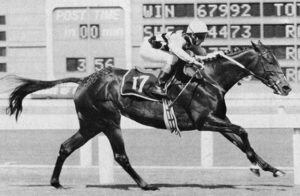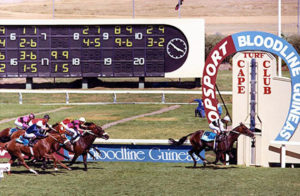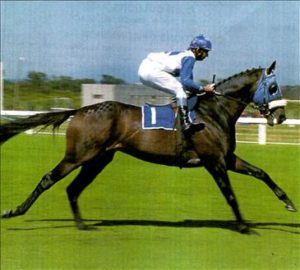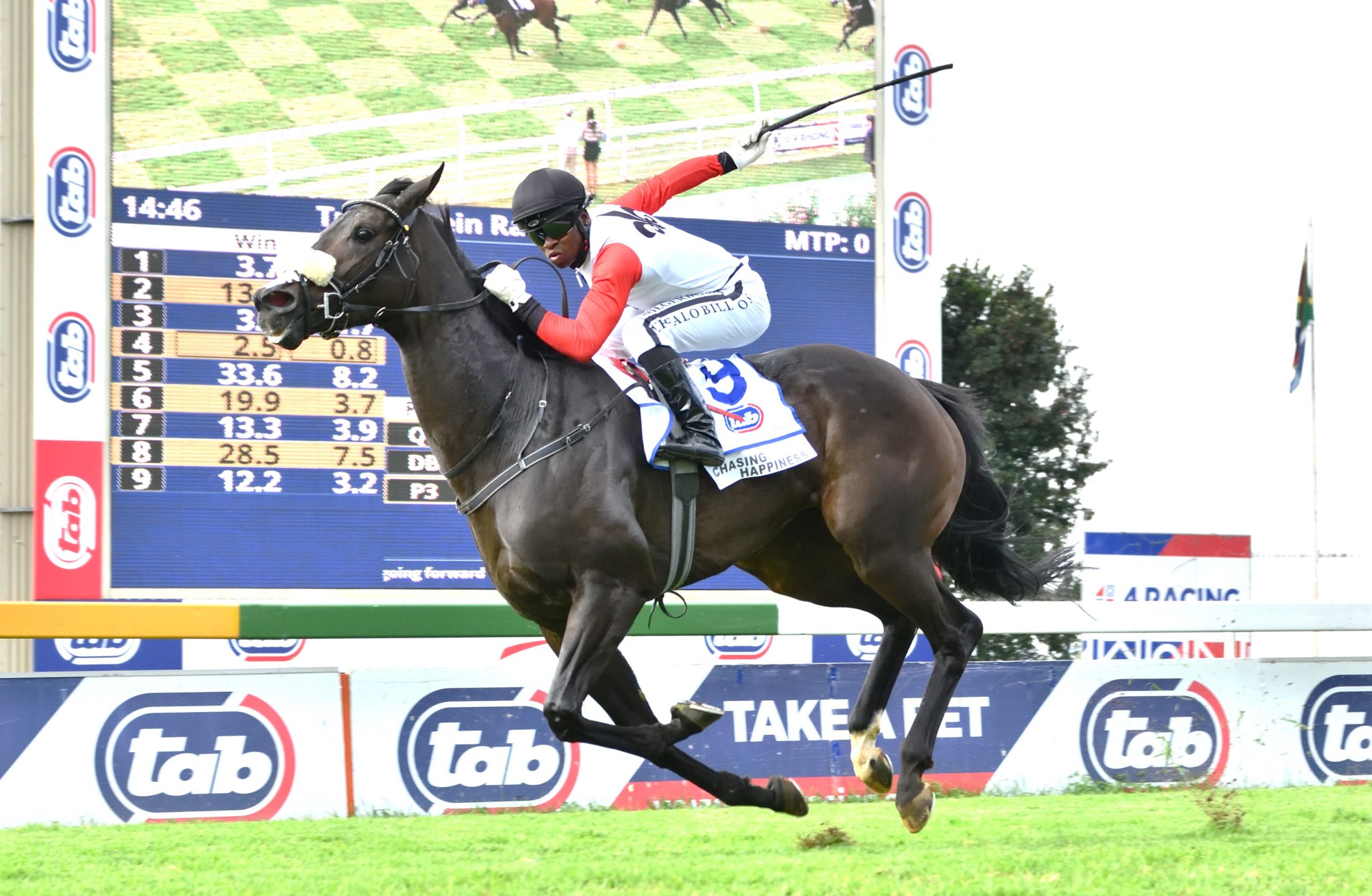
Empress Club winning the 1993 Gr1 J&B Met
Following last week’s re-published Racing Record essay on Star Effort, here’s one on another filly who beat the colts – Empress Club, born just one year after Star Effort. The essay highlights her 4yo career.
Empress Club – rated 126
Empress Club 4 b.f. by Farnesio – Elysee (El Gran Capitan); won 15 [this season ’93) 1000; 1600; 2000; 1600;]
Racing Record 1993

Empress Clubs wins the 1993 Gr1 Queen’s Plate
History is what historians make it. It isn’t necessarily a truthful account of events, merely a reflection of the way socially influential people see them. Clearly, the intellectual quality of these influential voices has great influence on the way future generations perceive the recorded events and background. Sadly, it seems rather likely that racing fans of the future will never be able to fully appreciate the quality of South African horses of the Eighties and Nineties. At least they won’t if the official ARCSA awards are used as the yardstick.
The ‘official’ Horse of the Year Awards were hijacked in the mid-Eighties by the Association of Racing Clubs of South Africa (ARCSA). Staunch supporters of the notion that great minds think by consensus, ARCSA made up a selection of what it perceived to be knowledgeable racing people to cast their votes. Unfortunately the ARCSA selection was neither representative nor knowledgeable. It resulted in Horse of the Year blunders such as Right Prerogative, the selection of Royal Chalice over Mark Anthony, and the non-election of Model Man. In recent years ARCSA made some token attempts to redress the imbalance noted by its critics, but never whole-heartedly or with purpose, and always authoritatively and without consultation.
The committee spirit persists at the expense of knowledge and understanding.
This was never more visible than in 1993, when the worst blunders of all were committed, not only in the Horse of the Year category – the titles for Stayer of the Year and Sprinter of the Year were equally poor in its final outcome. Although Horse of the Year awards will presumably cause controversy anywhere in the world, the glaring injustices done to some of this year’s South African losers put serious doubts as to the value of the local awards. Clearly, the fact that no one in particular will accept the responsibility for the final selection (or is remotely capable of motivating it) speaks volumes. Worst still, South Africa’s official handicappers are still incapable of producing season’s-end Classifications, so there isn’t even an ‘official’ yardstick to measure the ARCSA awards by.

Empress Clubs wins the 1992 Gr1 Cape Guineas
It is high time that both ARCSA and the Jockey Club took their respective responsibilities to racing’s intellectual heritage seriously. ARCSA in terms of instituting meaningful awards, which reflect selections that can be motivated and defended, before another party takes the bull by the horns. And the Jockey Club (whose sub committee on handicapping came up empty handed after no less than three years of apparently fruitless debate) in terms of education, in order to be able to align itself with internationally accepted handicapping methods.
The choice of Flaming Rock as Horse of the Year couldn’t have happened to a gamer, more consistent performer – but he wasn’t the best by a long shot.

Flaming Rock
Empress Club, earlier in the year billed as ‘the wonder filly’, beat Flaming Rock pointless on two of the three occasions they met. The Argentinian filly’s most convincing win was in the Gr1 Queens Plate, run at weight-for-age at the height of the Cape summer season, which she won by five lengths from the Irish-bred son of Ballad Rock. Empress Club won three Gr1’s and had a seasonal rating of 126 (Timeform comparable), against a single Gr1 win for Flaming Rock (TFR 123). There really was no comparison.
Empress Club started the season with what was generally regarded as a warm-up sprint at Durbanville, where she met a choice selection of seasoned sprinters over 1000m. The magnitude of her task was reflected in her starting price, with the bookmakers freely offering 4/1 about the top weight. Vying for favouritism were the previous season’s top sprint filly Marie Galante (16/10) and Taban, who would be given title of Sprinter of the Year at the end of the season in progress. Empress Club had been set to give 3 kilos to the filly, and half a kilo more to Taban. Marie Galante was in front from the break, and came into the straight with Taban at her quarters. Empress Club raced some 3 lengths back in third, moving smoothly, then drew level with the champion sprinters a furlong out to win going away by a length and a half. For good measure, Empress Club also broke the (hand-timed) course record to show that this win was no fluke.

Empress Club wins the 1992 Gr1 Administrators Cup
Two weeks later came the Gr1 Queen’s Plate. Run at weight-for-age, it was surprising that as many as fifteen opponents had the courage to face her at the start of the 1600m event at Kenilworth. Empress Club shortened in the betting to 5/10, with Flaming Rock (9/2) and Spanish Galliard (8/1) the only others in single figures. Flaming Rock’s stable mate King of the Strip set a useful pace, with the fancied horses in midfield. Some 400m from home the Empress gathered her skirts and with breathtaking acceleration took some three lengths on her field in the space of 200m. Well clear a furlong out, she extended her lead to 3.5 lengths over Flaming Rock at the finish. Spanish Galliard finished a modest third, beaten six lengths. The win caused clouds of chalkdust around bookmaker’s boards, where the filly was priced up at odds-on for the Gr1 J&B Met three weeks later. She didn’t disappoint her supporters, winning by 2 lengths from Flaming Rock, Secret Rites and Spanish Galliard.
Let’s pause for a minute and put the Empress’ first three runs of the season into perspective. She began by beating two of the country’s top sprinters, including the subsequent ARCSA Sprinter of the Year, over 1000m, in record breaking time, giving weight all round. She followed up by making hacks of the country’s best milers, at weight-for-age, including amongst her scalps the one of the subsequent ARCSA Horse of the Year. And at her third start she did the same effective demolishing job on the best middle distance racers, beating Flaming Rock over 2000m under identical weight conditions as in the Queen’s Plate. It’s worth noting that subsequent Gr1 Mainstay winner Secret Rites ran a well beaten third.
Empress Club reappeared on the Rand some five weeks later, in the Gr1 First National 1600m over a mile at Turffontein. The race was run at weight-for-age, which gave good reason to the bookmaker fraternity to price her up at 1/6 – and concentrate on bets for who would run second. The Empress cruised in, easing up by almost three lengths from Please Be True and Queens Gold, adversaries who might as well have raced on a different planet.
Despite her achievements, 4/10 seemed rather short odds on the Empress in the Gr1 Administrators Cup, a 2000m handicap run in alternate years at Turffontein and Gosforth Park, where the filly had been set to carry top weight of 58 kilos. Her connections had flown former champion jockey Felix Coetzee out from Hong Kong to take the ride as regular jockey Marcus was suspended. Incredulously, the Empress finished eighth, beaten six lengths by Cardinal Fury, who’d made all the running in what was announced as a new race record time. The record came as no surprise, as this was the first time ever that the race had been run at the Gosforth Park track!
The Jockey Club opened an official inquiry in to the events surrounding the Empress’ failure when rumours surfaced that all hadn’t been well with the filly’s blood picture before the race. The inquiry centred on Rule 70.1 which (broadly) deals with running on merit. The inquiry board heard expert evidence three weeks after the race and accepted that the filly’s blood picture had been within normal parameters given her previous blood picture history. It was now April, and the travelling feature race circus moved to Natal for the winter season.
Opening early 5/2 favourite for the Rothmans July, Empress Club drifted in the betting to 10/1 and more as rumours concerning her wellbeing kept on surfacing. Her connections did little to defuse the situation, refusing to commit themselves about whether she would run right up to the final declaration stage.
But once she was known to be a certain runner, the money poured on and Empress Club ended up 3/1 joint favourite together with stable companion Dancing Duel. She had been set to carry 58 kilos, joint top weight with Flaming Rock, who therefore was 2.5 kilos better off for a beating of less than 3 lengths in the J&B Met. Coming from well off the pace, Empress Club again didn’t show her kick, but even so was beaten less than 2 lengths in a bunched finish by Dancing Duel. Flaming Rock reproduced their J&B Met running. Indeed, at the weights (few pay attention to the effect of weights in the July handicap) Flaming Rock and Empress Club were the two horses that gave the best performance, with only winner Dancing Duel anywhere near them in terms of ability.
Empress Club found herself unable to reverse the ‘beaten favourite’ trend in the Gr1 Mainstay handicap over 1800m at Clairwood. She topped the boards at 18/10, with Cape Guineas and Derby winner Eli’s Truth next at 7/2, and Flaming Rock easy to back at 11/2. Flaming Rock carried 58 kilos, half more than Empress Club. Close to the pace throughout, Empress Club completely failed to show her acceleration. She finished ninth, five lengths behind winner Secret Rites, who was a mere nose ahead of unlucky loser Flaming Rock.
Empress Club, an athletic, muscular, quite leggy individual, has shown her best form over a mile. Her major asset is her ability to quicken in a few strides, the hallmark of class. Despite her relative failures later in the season, when seemingly all wasn’t well with her health, she showed herself superior as a four-year-old to the best sprinters, the best milers, and the best middle distance horses in the land. That the title of Horse of the Year was denied her was a travesty.
Early in the new season it was announced that Empress Club would continue her career in the US. Assuming that she regains her best form after what will be an unreasonably lengthy period of quarantine, it seems likely that the Empress as a 5yo will make her presence felt in the highest circles. The Americans are sure to treat her with respect – Argentinian mares, after all, have an excellent record on the West-coast. We’ll follow her exploits with great interest.








